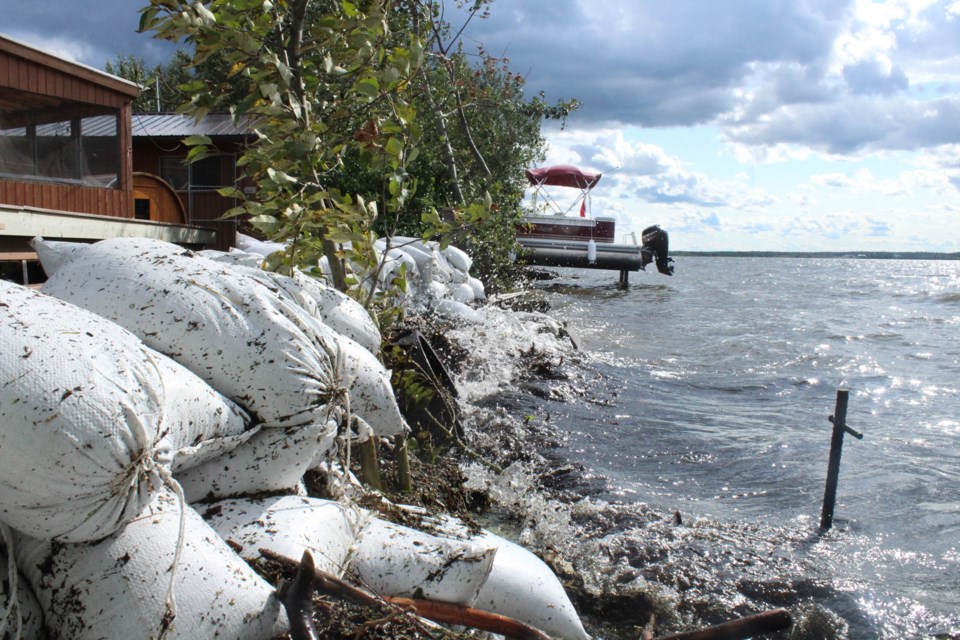Lakeside residents in several subdivisions around Lac La Biche lake have been bracing for the worst as lake levels rise towards their properties.
Sandbag stations have been created at areas around the lake, including White Sands near Plamondon and McGrane Estates at the Mission. The flooding threat triggered in June after unseasonably high levels of rain fell on the region.By some estimates the area received more than 10 inches of rain in the first two weeks of June. In the days following, Lac la Biche Lake levels began to rise from direct rainfall, increased inflow from the Owl River and run-off from the surrounding land.. Around the region, lake depths in most of the larger water bodies raised as much as four feet. While most other lakes have since stabilized, residents around Lac la Biche Lake continue to watch waters climb towards their homes.
Residents spoken to last week say it's the highest the water has been since 1997 and 1998. Before that, high levels were seen in 1963. Unlike in those years, however, say many who have witnessed it, this year the water levels aren't stabilizing.
Lac La Biche County mayor Omer Moghrabi and other area politicians have toured the areas. The concerns, they say, are primarily for the lakeside residents, but the high waters can affect lakeside infrastructure, roads and utilities that impact all residents. Speaking about the rising waters, the mayor said it's not just the rainfall and inflow that is causing the problem. In recent weeks strong northwestern winds have helped to crash waves as high as four-feet into the shores.
"The water keeps going up and we are expecting more rain. It's also the heavy winds that are causing problems," the mayor said last week after visiting residents along the west-facing shores of the Mission bay.
Statistical highs
The La Biche River flows from Lac la Biche Lake from north of Plamondon, travels through the White Russian settlement and joins the Athabasca River network that empties into the Arctic Ocean. According to the most recent statistics from Environment Canada, the water monitoring station on Lac la Biche lake — located near the David Thompson statue in the hamlet of Lac La Biche, has been recording levels nearing historic highs. In the 64 years of recorded data, September of 1997 recorded the highest water levels at the station. But the recent statistics from August 8-10 are the second highest on record, just 26 centimetres lower.
Outflow river might be plugging
One possible solution, said Moghrabi comes from a 1989 Alberta Environment report on the lake which explored the idea of building weirs at the inflow point from the Owl River and the outflow at the La Biche River to "control the levels of the lake".
Lac La Biche County councillor George L'Heureux had a similar suggestion, calling on municipal officials and residents to lobby the provincial government to allow significant dredging of the La Biche River so more water volumes could flow from the lake. Vegetation growth and development along the river might be a reason why lakewaters aren't flowing out, said L'Heureux, who sees the flooding dangers becoming a regular occurrence until a solution is found.
"This is not going to go away," he said.
Councillors say they will continue to explore ways to address the issue.
As the waters rise, sand bag stations will continue to be available in vulnerable areas. Sand bags are also available at several locations around the region, including the Plamondon Co-op and the Lac La Biche County offices.
Last week Lac La Biche County firefighters and crews from Alberta Wildland firefighters were helping to fill and stack sandbags for residents needing help.
More help is expected to be needed, says councillor Jason Stedman who lives in the Mission area.
"This is unprecedented, what's going on out there. The wind that we've had have been unbelievable. It's carved away five feet of shoreline in less that 24 hours in front of some people's houses," he said, emphasizing the municipality's commitment to helping its residents. "It's an issue of houses, it's an issue of lakeshore erosion. We should be providing what we can — be it bags, be it sand, and be it manpower sometimes in extreme cases to protect the assets of our county."

